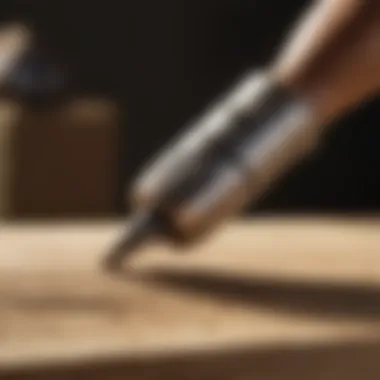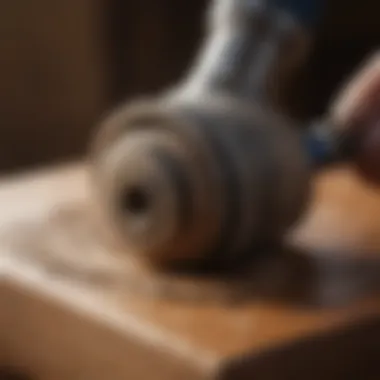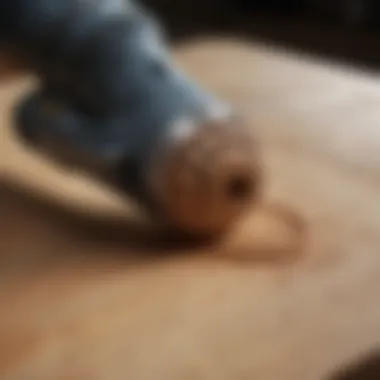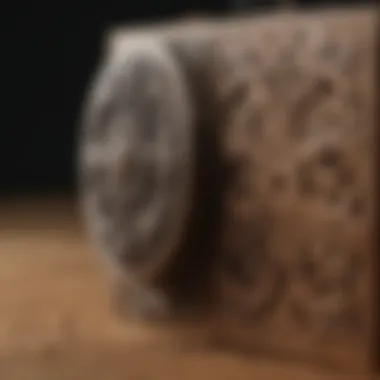Unlocking the Art of Wood Carving with Dremel Tool Attachments


Rock and Fossil Identification
Wood carving using Dremel tool attachments resembles a delicate dance between creativity and technique, where each movement shapes the final masterpiece. When embarking on this artistic journey, adequate identification of the right Dremel tool attachment plays a pivotal role in the process. Understanding the types of attachments available, such as cutting, carving, or polishing heads, is essential. Moreover, recognizing the unique characteristics of each attachment and knowing the specific tasks they excel at can greatly enhance the precision and quality of wood carvings. It is crucial to select the appropriate attachment based on the intricacy and style of the design envisioned, ensuring a seamless transition from concept to creation.
Collecting Tips and Techniques
Just as a seasoned geologist meticulously uncovers rare specimens in the natural world, a wood carver using Dremel tool attachments must also hone their collecting skills to procure the finest materials for their craft. An essential aspect of wood carving is sourcing high-quality wood that aligns with the desired aesthetic and technical requirements of the project. Delving into best practices for wood selection, understanding grain patterns, and assessing density are paramount in elevating the quality of the final carving. Furthermore, mastering the art of finding prime cutting sites, where the wood's natural beauty is exemplified, can elevate the artistic outcome. Safety measures during wood extraction are equally crucial, ensuring a seamless and secure harvesting process without compromising the integrity of the material.
Preservation and Display
Preserving the integrity and allure of a wood carving akin to conserving a rare geological artifact unearthed from the depths of the earth. Employing effective techniques for wood preservation, including appropriate finishes and sealants, is imperative in safeguarding the artwork from environmental factors and wear and tear. Furthermore, understanding the nuances of proper storage methods, such as temperature and humidity control, can prolong the lifespan of the carving and retain its original beauty. Creative display ideas play a significant role in showcasing the wood carvings, turning them into focal points of admiration. Whether opting for minimalist displays that accentuate the intricacies of the carving or elaborate arrangements that captivate attention, the presentation significantly influences the viewer's perception and appreciation of the artwork.
Geological Insights
Exploring the geological parallels in the realm of wood carving expands the artistic horizon, infusing historical significance and depth into the creation process. Identifying geological formations and processes reflected in the veining and grain patterns of wood enhances the contextual understanding of the material being carved. Delving into the historical significance of different wood types, tracing their origins and cultural influences, adds layers of meaning to the carving process. Moreover, drawing inspiration from notable woodcarvings throughout history offers insights into evolving carving techniques and styles, enriching the contemporary artistic landscape with echoes of the past.
Introduction to Wood Carving with Dremel Tools
Wood carving with Dremel tools is an art form that requires precision, skill, and the right set of tools. In this section, we will delve into the significance of utilizing Dremel tools for wood carving, focusing on the unique benefits they offer and the essential considerations for any woodworking enthusiast or professional. Dremel tools provide woodworkers with a versatile and efficient way to create intricate designs and detailed carvings, making them indispensable in the world of woodworking. Understanding the key elements of using Dremel tools for wood carving is crucial for achieving remarkable results that meet the highest standards of craftsmanship.
Overview of Dremel Tools
Dremel rotary tools are essential for wood carving due to their versatility and precision. These tools offer woodworkers the ability to carve, engrave, and polish with exceptional control and accuracy. The high-speed rotation provided by Dremel rotary tools allows for intricate detailing and shaping of wood, making them an ideal choice for intricate wood carving projects. Despite their power and capabilities, Dremel rotary tools may require skill and practice to master fully. Dremel accessories play a vital role in enhancing the functionality of Dremel tools. From cutting and grinding to sanding and polishing, these accessories expand the capabilities of Dremel tools, making them indispensable for various woodworking tasks. The versatility and ease of changing accessories make Dremel tools adaptable to different carving techniques, enabling woodworkers to achieve professional results with ease. However, frequent accessory changes may interrupt workflow, requiring careful planning for efficient woodworking. Recognizing the importance of attachments is key to optimizing the performance of Dremel tools for wood carving. Attachments provide additional functionality to Dremel tools, allowing woodworkers to tackle a wide range of projects with precision and ease. Understanding how attachments contribute to different carving techniques and designs is essential for optimizing the tool's performance and achieving superior results. However, selecting the right attachments may require experimentation and practice to determine the most suitable options for specific carving tasks.
Benefits of Using Dremel Tools for Wood Carving
Precision and control are paramount when it comes to wood carving, and Dremel tools excel in providing woodworkers with the accuracy and finesse needed for intricate designs. The ability to carve with precision ensures that every detail is captured flawlessly, enhancing the overall quality of the final piece. However, maintaining control over the tool requires practice and a steady hand, as even minor errors can impact the finished carving significantly. Versatility in carving techniques is a significant advantage offered by Dremel tools, allowing woodworkers to explore different artistic styles and approaches to wood carving. The flexibility to switch between carving techniques enables woodworkers to experiment with various design elements and textures, enhancing their creative expression and expanding their artistic horizons. Adapting carving techniques to different projects may require patience and skill to master effectively. Efficiency in detailed work is a defining feature of Dremel tools, enabling woodworkers to achieve intricate designs with speed and accuracy. The efficiency of Dremel tools in detailed work streamlines the carving process, making it possible to create complex designs efficiently. However, maintaining focus during detailed work is crucial to avoid any errors or inconsistencies that may compromise the final outcome.


Choosing the Right Dremel Tool for Wood Carving
Variable speed options are a critical consideration when selecting a Dremel tool for wood carving. The ability to adjust the tool's speed allows woodworkers to control the cutting, shaping, and detailing process with precision. Variable speed options offer versatility in handling different types of wood and carving techniques, making them essential for achieving professional results. However, mastering the use of variable speed options requires a keen understanding of how speed impacts the carving process and the final outcome. Comfort and ergonomics play a vital role in ensuring prolonged use of Dremel tools without discomfort or fatigue. Ergonomically designed tools reduce strain on the hands and wrists during extended carving sessions, promoting better control and accuracy. Comfortable tools also enhance the woodworker's overall experience, making the carving process more enjoyable and productive. Prioritizing comfort and ergonomics in tool selection is crucial for preventing injuries and achieving consistent results in wood carving projects. Compatibility with attachments is a key feature to consider when choosing a Dremel tool for wood carving. The compatibility of the tool with a wide range of attachments expands its functionality, allowing woodworkers to experiment with different carving techniques and styles. An attachment-compatible tool provides woodworkers with flexibility and versatility in tackling diverse woodworking projects, enhancing their creative potential. However, ensuring compatibility with attachments may require careful research and consideration to select the most suitable tool for specific carving tasks.
Types of Attachments for Wood Carving
Carving Bits
Carving bits are instrumental in shaping and detailing wood carvings with utmost precision. Their key characteristic lies in their ability to carve intricate designs and contours smoothly. The unique feature of carving bits is their versatility, allowing craftsmen to create intricate patterns and textures effortlessly. While they excel in detailed work, some may find them less suitable for extensive material removal due to their smaller size.
Sanding Drums
Sanding drums play a vital role in refining rough surfaces and achieving a smooth finish in wood carving projects. Their key characteristic is the even sanding they provide, ensuring a uniform texture on the carved surfaces. The unique feature of sanding drums is their efficiency in smoothing curved or irregular surfaces, making them a popular choice for achieving professional-quality finishes. However, they may generate more dust compared to other attachments.
Engraving Cutters
Engraving cutters are essential for creating intricate designs and adding fine details to wood carvings. Their key characteristic is the precision they offer in carving intricate patterns and texts into the wood surface. The unique feature of engraving cutters is their ability to work on various materials besides wood, expanding their utility beyond wood carving. However, their sharp edges require careful handling to prevent accidents or damages.
Routing Accessories
Routing accessories are ideal for intricate designs and shaping tasks, providing versatility in creating special cuts and customized edges. Their key characteristic is the versatility they offer in shaping wood and creating decorative edges. The unique feature of routing accessories is their ability to work on different wood densities, making them a sought-after choice for diverse wood carving projects. However, they may require additional caution due to their cutting precision.
Best Practices for using Dremel Tool Attachments
Securing the Workpiece
Securing the workpiece is essential to ensure stability and safety during the wood carving process. Its key characteristic lies in providing a stable base for carving, preventing unexpected movements that could lead to accidents or errors. The unique feature of securing the workpiece is its adaptability to various sizes and shapes of wood, offering a secure base for intricate carving tasks. However, improper securing may result in uneven carving or damage to the workpiece.
Proper Technique for Each Attachment


Mastering the proper technique for each attachment is crucial for achieving optimal results in wood carving. The key characteristic is the adherence to specific movements and angles required for each attachment, ensuring precision and finesse in carving. The unique feature of proper technique is its ability to maximize the effectiveness of each attachment, bringing out the best results in wood carving projects. However, mastering these techniques may require practice and patience to achieve proficiency.
Safety Precautions
Adhering to safety precautions is paramount to prevent injuries and ensure a secure working environment when using Dremel tool attachments. The key characteristic is the focus on protective gear and safe handling practices to minimize risks during the carving process. The unique feature of safety precautions is their role in fostering a safe and controlled working environment, promoting a secure and enjoyable wood carving experience. However, negligence towards safety measures may result in accidents or damages to both the craftsman and the workpiece.
Maintenance and Care of Dremel Attachments
Cleaning and Storage
Proper cleaning and storage of Dremel attachments are essential for maintaining their efficiency and longevity. The key characteristic is the regular cleaning to remove debris and residues that may affect the attachment's performance. The unique feature of cleaning and storage is its impact on prolonging the lifespan of attachments, ensuring consistent functionality in wood carving tasks. However, improper cleaning or storage practices may lead to reduced effectiveness or premature wear of attachments.
Replacing Worn-Out Attachments
Recognizing and replacing worn-out attachments in a timely manner is crucial to avoid compromising the quality of wood carvings. The key characteristic is monitoring the attachment's wear and performance to determine the need for replacement. The unique feature of replacing worn-out attachments is its contribution to maintaining precision and efficiency in wood carving, avoiding inconsistencies or damages due to worn attachments. However, overlooking worn-out attachments may result in subpar carving results or unnecessary strain on the tool.
Extending the Lifespan of Attachments
Implementing practices to extend the lifespan of attachments is key to maximizing their utility and value in wood carving projects. Their key characteristic involves proper handling, cleaning, and maintenance to ensure longevity and optimal performance. The unique feature of extending the lifespan of attachments is the cost-saving benefits and improved productivity they provide, allowing craftsmen to focus on their artistry without frequent interruptions or replacements. However, neglecting maintenance routines may shorten the lifespan of attachments and lead to unexpected inefficiencies in wood carving tasks.
Advanced Techniques and Tips for Dremel Wood Carving
In the realm of wood carving using Dremel tool attachments, delving into advanced techniques and tips is pivotal. Mastery of these intricate methods elevates the quality and detail of wood carvings, making them truly exceptional. By focusing on refining one's skills and exploring innovative approaches, woodworkers can achieve intricate designs that captivate the eye and push the boundaries of creativity. Understanding and implementing these advanced techniques not only enhance the final product but also demonstrate a profound level of craftsmanship that sets artisans apart in the realm of wood carving.
Creating Intricate Designs
Layering techniques:
Layering techniques in wood carving involve the art of adding depth and dimension to creations by stacking or overlaying materials strategically. This method enriches the visual appeal of the carving, creating a sense of realism and complexity. The key characteristic of layering techniques lies in their ability to transform flat surfaces into multidimensional artworks, infusing life and texture into the wood. Woodworkers opt for layering techniques in this article for their capacity to add sophistication and depth to intricate wood carvings.


Texturing methods:
Texturing methods play a crucial role in wood carving by imparting tactile and visual interest to the finished pieces. These techniques involve creating patterns, lines, and surface irregularities that enhance the overall appeal of the carving. The unique feature of texturing methods is their ability to evoke different sensations and moods through the varied textures applied to the wood. In this article, texturing methods are favored for their capacity to elevate the artistic value of wood carvings and create captivating surfaces that engage the senses.
Shading and highlighting:
Shading and highlighting techniques are essential for adding depth and contrast to wood carvings, bringing out details and creating visual interest. By using light and shadow strategically, woodworkers can accentuate specific areas of a carving, adding a three-dimensional quality. The unique feature of shading and highlighting lies in their ability to imbue carvings with realism and nuance, enhancing the overall aesthetic appeal. In this article, shading and highlighting techniques are valued for their capacity to refine and amplify the beauty of intricate wood carvings.
Utilizing Specialized Attachments
Flex-shaft attachment:
Utilizing a flex-shaft attachment enhances the precision and reach of Dremel tools, allowing woodworkers to work on intricate details with ease. Its key characteristic lies in its flexibility, enabling creators to maneuver around curves and tight spaces effortlessly. The unique feature of the flex-shaft attachment is its ability to enhance control and accuracy, making it a popular choice in this article for tackling intricate wood carving projects.
Detailer's grip:
The detailer's grip attachment offers improved ergonomics and control, enhancing the woodworker's ability to maneuver the Dremel tool with precision. Its key characteristic is its comfortable grip and ergonomic design, reducing strain and fatigue during extended carving sessions. The unique feature of the detailer's grip lies in its ability to provide stability and accuracy, making it a preferred choice in this article for achieving flawless detailing in wood carvings.
Circle cutter:
The circle cutter attachment facilitates the creation of precise circular shapes in wood carvings, adding a unique element to the design. Its key characteristic is its efficiency in producing consistently accurate circles, saving time and effort in carving intricate patterns. The unique feature of the circle cutter lies in its ability to create symmetrical forms effortlessly, making it an advantageous choice in this article for achieving curved details in wood carvings.
Troubleshooting Common Issues
Overheating of attachments:
Facing overheating issues with attachments can hamper the carving process, leading to potential damage and inefficiencies. The key characteristic of addressing overheating is preserving the integrity of attachments and ensuring their longevity. While overheating poses disadvantages like heightened risk of wear and tear, managing this issue in this article is crucial to maintaining optimal performance and extending the lifespan of attachments.
Loss of power:
Experiencing a loss of power in Dremel tools can hinder the carving process, disrupting workflow and diminishing efficiency. The key characteristic of combatting power loss is ensuring consistent performance and uninterrupted carving sessions. While a loss of power can disadvantageously disrupt work rhythm, rectifying this issue in this article is vital for achieving seamless wood carving and maximizing productivity.
Attachment slippage:
Attachment slippage can impede progress during wood carving, causing inaccuracies and inconsistencies in the final piece. The key characteristic of addressing attachment slippage is maintaining stability and secure connections for precise carving outcomes. While attachment slippage presents disadvantages like compromised detailing, mitigating this issue in this article is essential for achieving smooth and flawless wood carvings.







